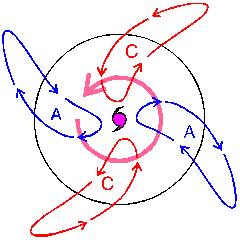 In a horizontally sheared environmental current, a barotropic,
but otherwise hurricane--like, vortex exhibits a
wavenumber 2 asymmetry forced directly by mutual
advection of the shear flow and the axisymmetric vortex
swirling flow. The asymmetries are Rossby waves that propagate
upon the radial gradient of axisymmetric potential vorticity.
The waves move against the swirling flow so that their phase
lines remain stationary. In a cyclonically sheared
environment, eddy transports of angular momentum and wave
energy are inward and outward, respectively. Although they
arise in a barotropic model, these asymmetries have exactly the
properties expected of the upper tropospheric eddies
hypothesized to modulate tropical cyclone intensity changes.
In the above sketch, alternating cyclonic (red) and anticyclonic
(blue) bands transport cyclonic angular momentum inward through
the black circle, nominally 2000 km in radius. This transport
tends to spin up the vortex primary circulation (magenta).
In a real hurricane, upper-level transports of this sort would
force a quasi balanced outflow that would, in turn, destabilize
the thermodynamic sounding and invigorate the convection.
In a horizontally sheared environmental current, a barotropic,
but otherwise hurricane--like, vortex exhibits a
wavenumber 2 asymmetry forced directly by mutual
advection of the shear flow and the axisymmetric vortex
swirling flow. The asymmetries are Rossby waves that propagate
upon the radial gradient of axisymmetric potential vorticity.
The waves move against the swirling flow so that their phase
lines remain stationary. In a cyclonically sheared
environment, eddy transports of angular momentum and wave
energy are inward and outward, respectively. Although they
arise in a barotropic model, these asymmetries have exactly the
properties expected of the upper tropospheric eddies
hypothesized to modulate tropical cyclone intensity changes.
In the above sketch, alternating cyclonic (red) and anticyclonic
(blue) bands transport cyclonic angular momentum inward through
the black circle, nominally 2000 km in radius. This transport
tends to spin up the vortex primary circulation (magenta).
In a real hurricane, upper-level transports of this sort would
force a quasi balanced outflow that would, in turn, destabilize
the thermodynamic sounding and invigorate the convection.
References
Molinari, J. and D. Vollaro, 1989: External influences on hurricane intensity: Part I. Outflow layer eddy angular momentum fluxes. J. Atmos. Sci. , 46 , 1093-1105.
Pfeffer, R. L., 1958: Concerning the Mechanics of
Hurricanes. J. Meteorology, 15,
113-120.
Willoughby, H. E., 1996: Nonlinear motion of a shallow-water barotropic vortex in an environmental zonal flow. J. Atmos. Sci.,53, (draft).